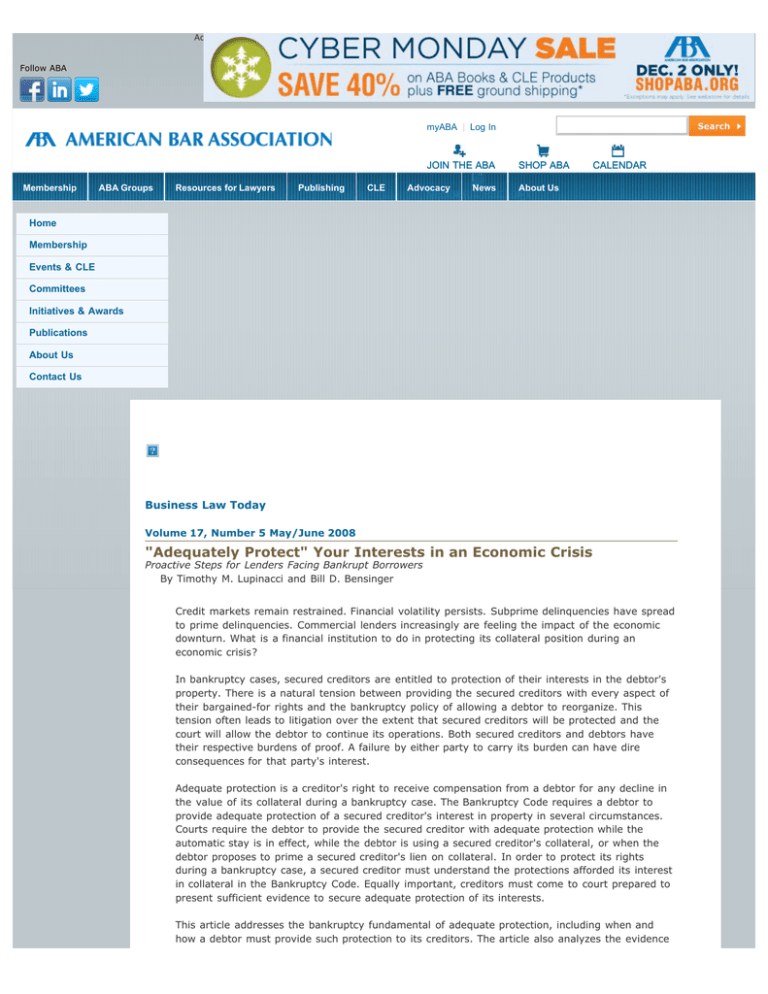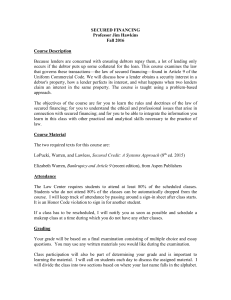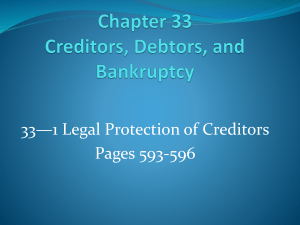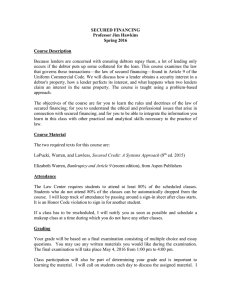
Advertisement
Follow ABA
myABA | Log In
JOIN THE ABA
Membership
ABA Groups
Resources for Lawyers
Publishing
CLE
Advocacy
News
SHOP ABA
CALENDAR
About Us
MEMBER DIRECTORY
Home
Membership
Events & CLE
Committees
Initiatives & Awards
Publications
About Us
Contact Us
Business Law Today
Volume 17, Number 5 May/June 2008
"Adequately Protect" Your Interests in an Economic Crisis
Proactive Steps for Lenders Facing Bankrupt Borrowers
By Timothy M. Lupinacci and Bill D. Bensinger
Credit markets remain restrained. Financial volatility persists. Subprime delinquencies have spread
to prime delinquencies. Commercial lenders increasingly are feeling the impact of the economic
downturn. What is a financial institution to do in protecting its collateral position during an
economic crisis?
In bankruptcy cases, secured creditors are entitled to protection of their interests in the debtor's
property. There is a natural tension between providing the secured creditors with every aspect of
their bargained-for rights and the bankruptcy policy of allowing a debtor to reorganize. This
tension often leads to litigation over the extent that secured creditors will be protected and the
court will allow the debtor to continue its operations. Both secured creditors and debtors have
their respective burdens of proof. A failure by either party to carry its burden can have dire
consequences for that party's interest.
Adequate protection is a creditor's right to receive compensation from a debtor for any decline in
the value of its collateral during a bankruptcy case. The Bankruptcy Code requires a debtor to
provide adequate protection of a secured creditor's interest in property in several circumstances.
Courts require the debtor to provide the secured creditor with adequate protection while the
automatic stay is in effect, while the debtor is using a secured creditor's collateral, or when the
debtor proposes to prime a secured creditor's lien on collateral. In order to protect its rights
during a bankruptcy case, a secured creditor must understand the protections afforded its interest
in collateral in the Bankruptcy Code. Equally important, creditors must come to court prepared to
present sufficient evidence to secure adequate protection of its interests.
This article addresses the bankruptcy fundamental of adequate protection, including when and
how a debtor must provide such protection to its creditors. The article also analyzes the evidence
necessary for a secured creditor to receive adequate protection.
The Purpose of Adequate Protection
The concept of adequate protection derives from the Fifth Amendment protection of property
interests.Adequate protection, however, is more than a constitutional protection of creditor's
interest in property. Section 361 of the Bankruptcy Code and the concept of adequate protection
generally are based as much on policy grounds. Congress has noted (see H.R. Rep. No. 95-595,
at 339 (1978)) that
[s]ecured creditors should not be deprived of the benefit of their bargain. There may be situations
in bankruptcy where giving a secured creditor an absolute right to his bargain may be impossible
or seriously detrimental to the bankruptcy laws. Thus, § 361 recognizes the availability of
alternate means of protecting a secured creditor's interest. Though the creditor might not receive
his bargain in kind, the purpose of the section is to insure that the secured creditor receives in
value essentially what he bargained for.
The basic purpose of adequate protection is to replace the protections afforded a secured creditor
by a bankrupt debtor's continued possession of its collateral.Adequate protection payments are
designed to compensate the holder of a secured claim for any decline in the value of its collateral
that occurs after the bankruptcy filing.There is no express statutory requirement that unsecured
creditors be provided adequate protection.
I Want More. Now!
The Bankruptcy Code requires a debtor to provide adequate protection to a secured creditor in at
least three circumstances: (1) when the secured creditor seeks to lift the automatic stay and the
court finds that there is a lack of adequate protection; (2) when the debtor uses, sells, or leases a
secured creditor's collateral; and (3) when the debtor proposes to prime a secured creditor's lien
with an additional lien. In two of these instances, a secured creditor must request that the
bankruptcy court order the debtor to provide adequate protection of the secured creditor's
interest. While the stay provisions of section 362 require that a secured creditor's interest be
adequately protected, most courts still require that the secured creditor actually request the relief
or adequate protection prior to the court ordering it.The bankruptcy court may condition the
continuation of the automatic stay on the provision of adequate protection, but the lien creditor
must first "request" relief from the stay.
Similarly, secured creditors must request adequate protection when a debtor intends to use, sell,
or lease the secured creditor's noncash collateral. Section 363(e) states that "upon request of an
entity that has an interest in property used, sold, or leased . . . the court . . . shall prohibit or
condition such use, sale, or lease as is necessary to provide adequate protection of such interest."
Courts place the onus of requesting adequate protection in this context on the secured creditor.
The rules are different when the debtor wants to use cash secured by a lender's lien. The
Bankruptcy Code provides that a debtor cannot use this cash collateral unless it first provides the
secured creditor with adequate protection. The debtor does not have the right to use cash
collateral without either the consent of the secured creditor or an order of the court.
A secured creditor does not have to request adequate protection when the debtor attempts to
prime the secured creditor's interest in collateral with another lien. Section 364(d)(1) of the
Bankruptcy Code requires that before priming a lender's existing lien, the trustee must adequately
protect the initial lienholder's interest. Courts require the debtor to provide adequate protection in
all cases where a secured creditor's interest will be primed by an additional lien.
A Chapter 13 debtor also must provide a secured creditor with adequate protection as part of its
plan payments. The Bankruptcy Abuse Prevention Consumer Protection Act of 2005 (BAPCPA)
amended section 1325(a)(5)(B) of the Bankruptcy Code to require a Chapter 13 debtor to make
periodic distributions to secured creditors as part of its plan in an amount that is sufficient to
provide the secured creditor with adequate protection.
I Ain't Saying You're a Gold Digger, but . . .
The judicial determination of how a debtor actually provides sufficient adequate protection
continues to evolve. The Bankruptcy Code sets forth three nonexclusive examples of what may
constitute adequate protection.Section 361 states that
[A]dequate protection may be provided by
(1) requiring the [debtor] to make a cash payment or periodic cash payments to such entity, to
the extent that the stay under section 362 of this title, use, sale, or lease under section 363 of
this title, or any grant of a lien under section 364 of this title results in a decrease in the value of
such entity's interest in such property;
(2) providing to such entity an additional or replacement lien to the extent that such stay, use,
sale, lease, or grant results in a decrease in the value of such entity's interest in such property; or
(3) granting such other relief, other than entitling such entity to compensation allowable under
section 503(b)(1) of this title as an administrative expense, as will result in the realization by such
entity of the indubitable equivalent of such entity's interest in such property.
Making periodic cash payments is the most common way that a debtor provides adequate
protection to its secured creditors.
A debtor may also provide adequate protection by granting additional or replacement liens in the
debtor's assets. The replacement lien scenario typically arises when the secured creditor has a
pre-petition lien on accounts, inventory, and other "soft collateral." The commencement of a
bankruptcy case cuts off a secured creditor's interest in property acquired post-bankruptcy.
Bankruptcy courts allow a debtor to provide adequate protection to a secured creditor by granting
a security interest in the accounts, inventory, and other such property acquired post-petition.The
replacement lien protects the secured lender by granting a replacement lien in the post-petition
generated assets.
The final illustrative means of adequate protection found in section 361 is for the debtor to
provide the secured creditor with the "indubitable equivalent" of its interest, a term not defined in
the Bankruptcy Code.A debtor cannot provide this adequate protection by granting an
administrative expense priority. Conversely, courts have consistently held that a debtor can
provide the indubitable equivalent of a secured creditor's interest by surrendering the collateral to
the creditor.Within these parameters, the indubitable equivalent is limited only by the imagination
of debtor's counsel.The indubitable equivalent standard of section 361(3) "is designed to broaden,
not circumscribe the range of solutions available to debtors and creditors in accommodating their
respective interests in the infinite number of variations possible in their dealings." In re Shriver,
33 B.R. 176, 183 (Bankr. N.D. Ohio 1983).
Some courts have found that a secured creditor is adequately protected if it has a lien on, or
access to, assets outside of the bankruptcy estate. Similarly, a guarantee by a third party can be
a form of adequate protection.In such cases, the key to whether a guarantee adequately protects
the secured creditor is whether such a guarantee is secured by collateral.A secured creditor's lien
on property, some of which is owned by nondebtors, can afford the creditor adequate protection.
Justify Your Adequate Protection
While the debtor always bears the burden of proving adequate protection, the secured creditor has
significant burdens before the debtor must offer its proof. When the Bankruptcy Code requires the
secured creditor to request adequate protection, the secured creditor bears the initial burden of
going forward in regards to certain issues, even if it does not bear the ultimate burden of
persuasion. The issues for which the secured creditor must carry the initial burden depends on the
applicable section of the Bankruptcy Code governing the requested relief. If the secured creditor
fails to carry its initial burden, the court may dismiss the motion without requiring the debtor to
offer any evidence.
1. Relief from Stay for Cause.
Under section 362(d)(1) of the Bankruptcy Code, the secured creditor must prove that cause
exists for the requested relief.Generally, courts have held that the creditor has the burden of
showing that continuation of the stay would cause some affirmative harm to its interest in the
property. To establish a prima facie case under section 362(d)(1), a secured creditor should
introduce evidence of (1) a debt owing from the debtor to the secured creditor; (2) a valid
security interest that secures the debt; and (3) a decline in value of the property securing the
debt, combined with the debtor's failure to provide adequate protection of the secured creditor's
interest.
Without evidence of the amount of the debt, "the court is unable to find cause to lift the stay."
See In re Kleinbrink, 346 B.R. 734, 761 (Bankr. N.D. Tex. 2006). The burden of proving the debt
is straightforward; a duly executed and filed proof of claim "shall constitute prima facie evidence
of the validity and amount of the claim." Fed. R. Bankr. P. 3001(f). Supporting evidence, by
affidavit or live testimony, can help establish the debt. To establish a perfected security interest,
the secured creditor should file its perfection documentation with its claim.
Erosion of the secured creditor's position may be shown through evidence of declining property
values, the increasing amount of the secured debt through interest accruals or otherwise, the
nonpayment of taxes or other senior liens, failure to insure the property, failure to maintain the
property, or other factors that may jeopardize the creditor's present interest in the property. This
evidence is proven through expert or other live testimony and typically includes testimony
establishing the declining value of the property.
Once the secured creditor makes a prima facie showing of cause, the burden then shifts to the
debtor to refute the existence of cause.When the secured creditor has moved for relief because of
lack of adequate protection, the debtor can refute the existence of cause either by proving that
the property is not decreasing in value or that the secured creditor is adequately protected.The
debtor bears the burden of proof by a preponderance of the evidence that cause to modify the
stay does not exist.
2. Adequate Protection for Debtor's Use, Sale, or Lease of Collateral.
When a debtor seeks to use, sell, or lease property that secures a creditor's claim, the party
bearing the burden of proof depends on the type of property at issue. The secured creditor
requesting adequate protection relating to assets other than cash has the initial burden of going
forward on certain issues. If the debtor seeks to use a secured creditor's cash collateral, the
debtor has the burden of proving adequate protection of the secured creditor's interest in cash
collateral.
The secured creditor asserting an interest in noncash collateral must prove the validity, priority, or
extent of its interest. The secured creditor must demonstrate that adequate protection is required
by showing a likelihood that the collateral will decrease in value on account of the debtor's use,
sale, or lease of the collateral.
If the secured creditor carries its initial burden of going forward, the burden then shifts to the
debtor. Likewise, if the debtor seeks to use cash collateral, the debtor bears the entire burden of
providing adequate protection.The courts have split as to the burden of proof that the debtor must
carry. Some bankruptcy courts require clear and convincing evidence.Other courts require proof
by the preponderance of the evidence.The debtor must show that either adequate protection is not
needed or it can be provided in a different manner.
3. Adequate Protection of a Primed Creditor's Interest.
When a debtor seeks to prime a secured creditor's lien under section 364, the debtor has the
burden of proving adequate protection of the secured creditor's interest. Whether protection is
adequate depends on how effectively it compensates the secured creditor for the loss of value
caused by the superpriority lien given to secure the post-petition loan. The proposal should
provide the pre-petition secured creditor with the same level of protection it would have had if
there had not been post-petition superpriority financing. A debtor seeking to prime a secured
creditor should present an evidentiary foundation of adequate protection premised on facts or
projections.
Still Haven't Found What I'm Looking For
In litigating adequate protection, it is critical for the secured creditor to present sufficient evidence
to prevail. When a party bears the ultimate evidentiary burden, it is important to present effective
witnesses and documentary evidence to the bankruptcy court.Courts generally consider affidavits
submitted in support of motions, although there are limitations in relying solely upon affidavits.
Courts can take judicial notice of a debtor's bankruptcy schedules or other pleadings filed in a case
when property value is at issue.Bankruptcy schedules qualify for use as an admission by a partyopponent under Federal Rule of Evidence 801(d)(2). Schedules are (a) intended by the debtor
declarant as an assertion, (b) relevant to the question of value, and (c) being used against the
party declarant.
Appraisals are admissible as business records if they satisfy three basic requirements: (1) the
appraisal is kept in the course of a regularly conducted business activity, (2) it is the movant's
regular business practice to make the record, and (3) the source of the information or the method
or circumstances of preparation must not indicate lack of trustworthiness.The appraisal is
admissible as evidence on a motion for relief from stay only if the opinion as to the value
expressed therein is supported by live testimony, affidavit, or deposition testimony of the
appraiser. The movant must lay a proper evidentiary foundation for the appraiser's expertise.The
most effective presentation of valuation testimony is through the use of a live expert witness.
The evidence sufficient to prove adequate protection varies by case. Below is a list
of cases involving a secured creditor's attempt to prove adequate protection of its
interest in a debtor's property.
Secured creditor showed a decline in the value of the collateral over the two years prior to the petition
date but did not carry their burden of showing that the decline continued post-petition. The secured
creditor proved that a herd of cattle had a value of $89,800 two years prior to the petition date and a
value of $54,000 as of the petition date. The secured creditor, however, failed to show that the
depreciation continued post-petition. Zink v. Vanmiddlesworth, 300 B.R. 394, 402-03 (Bankr. N.D. N.Y.
2003).
When a debtor seeks to prime a creditor's pre-petition lien with a lien to a post-petition lender, the
debtor must show that it will be in a likely position to repay the post-petition loan while servicing the
pre-petition debt. If the debtor fails its evidentiary burden, the court cannot approve the post-petition
financing because the primed creditor is not adequately protected. In re Campbell Sod, Inc., 378 B.R.
647, 654 (Bankr. D. Kan. 2007).
A stream of payments alone cannot constitute adequate protection. The debtor must also show that the
creditor is protected against the risk of collateral destruction through physical damage insurance. In re
Jones, 2007 WL 2702117, at *1 (Bankr. M.D. Ala. 2007).
Secured creditor may prove declining property values, increase in amount of the secured debt,
nonpayment of taxes or other senior liens, failure to insure the property, failure to maintain the
property, or other factors that may jeopardize the creditor's present position. It may be necessary to
show a combination of these factors and/or to show that the circumstances as a whole are sufficient to
jeopardize the creditor's interest in the property warranting adequate protection. In re Anthem
Communities/RBG, LLC, 267 B.R. 867, 871 (Bankr. D. Colo. 2001).
In determining the amount of adequate protection a creditor is entitled to receive on its secured claim,
absent more reliable evidence, the average rate of decline in the blue book value of the particular
automobile over a three-month period immediately preceding the date of the request for adequate
protection should be used. In re Cook, 205 B.R. 437, 440-41 (Bankr. N.D. Fla. 1997).
If a secured creditor's collateral consists of rents, evidence that the stream of rents is declining, and that
the renewal rents are not providing constant value, is evidence of lack of adequate protection. In re
Wrecclesham Grange, Inc., 221 B.R. 978, 981 (Bankr. M.D. Fla. 1997).
To prove a decline in value, the movant must establish value at a beginning point, which is the
benchmark. It then must show a decrease in that value. The secured creditor can show this by a
comparison with a second value at the end of the protected period, by a previous decline from an earlier
date (i.e., filing date, which is expected to continue), or by a straight-line depreciation. In re Cason, 190
B.R. 917, 928 (Bankr. N.D. Ala. 1995).
Securedcreditor's collateral of publicly traded stock was not declining despite evidence that the stock
price had gone from $131/8 on the petition date of June 17, to a price of $101/4 on August 24. On
cross-examination, the secured creditor's expert testified that the decline was temporary and expected
the stock price to climb. In re Johnson, 90 B.R. 973, 976 (Bankr. D. Minn. 1988).
Secured creditor can prove diminution in value by showing that similar property is decreasing in value.
The secured creditor showed through expert witness testimony that farm land values in the same
geographic area had declined by at least 24 percent in the 12-month period immediately preceding the
filing of the petition in bankruptcy. Norwest Bank Worthington v. Ahlers, 794 F.2d 388 (8th Cir. 1986),
rev'd on other grounds, 485 U.S. 197.
Adequate protection exists if the value of a secured creditor's collateral exceeds the value of its claim
and the difference is either great enough to absorb interest accrual or the debtor is servicing the postpetition debt. An equity cushion of 20 percent or more constitutes adequate protection, while a rapidly
deteriorating equity cushion of less than 10 percent may be insufficient to constitute adequate
protection. In re James River Associates, 148 B.R. 790, 796 (E.D. Va. 1992).
Lupinacci is a shareholder and Bensinger is an associate at Baker, Donelson, Bearman, Caldwell &
Berkowitz, PC, in Birmingham, Alabama. Their respective e-mails are
tlupinacci@bakerdonelson.com and bbensinger@bakerdonelson.com.
Back to Top
For the Public
ABA Approved Law Schools
Resources For
Bar Associations
Law School Accreditation
Public Education
Diversity
Government and Public
Sector Lawyers
Public Resources
Judges
Law Students
|
Code of Conduct
|
Privacy Policy
|
Your Privacy Rights
|
Copyright & IP Policy
Stay Connected
Twitter
Facebook
Senior Lawyers
Solo and Small Firms
ABA Career Center
Contact Us Online
Women Lawyers
Young Lawyers
Lawyers of Color
Lawyers with Disabilities
Terms of Use
Lesbian, Gay, Bisexual &
Transgender Lawyers
Military Lawyers
|
Advertising & Sponsorship
|
© 2012 ABA, All Rights Reserved





